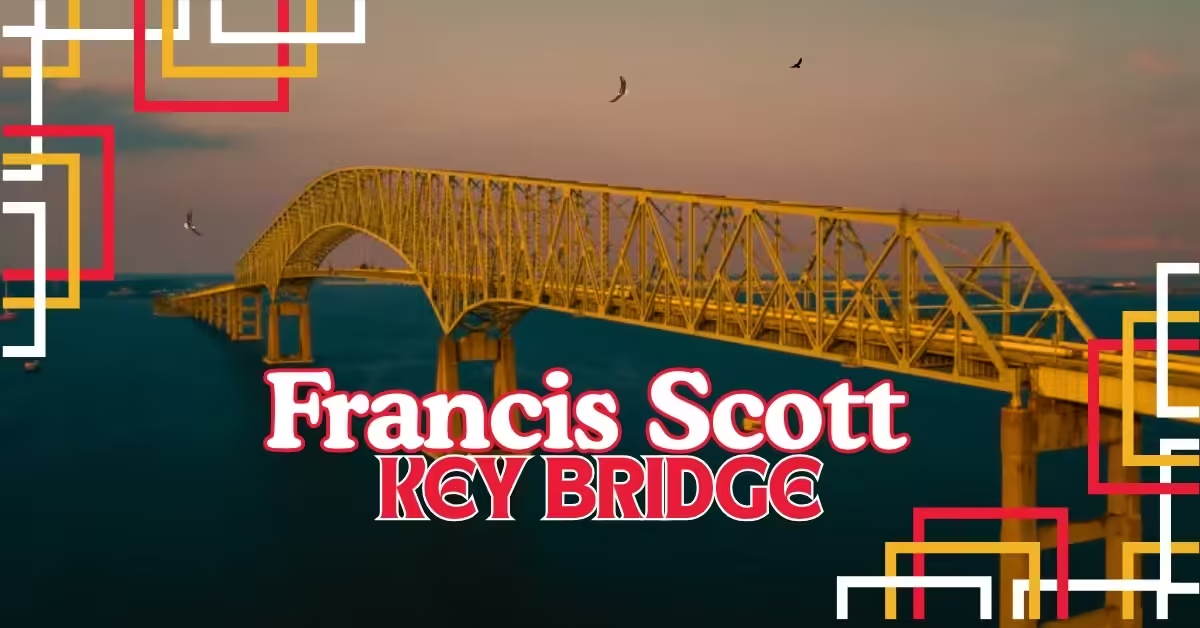Introduction to Francis Scott Key Bridge Baltimore
The Francis Scott Key Bridge in Baltimore is one of Maryland’s most iconic structures, stretching across the Patapsco River and connecting major parts of the Baltimore metropolitan area. Commonly known as the Key Bridge, this engineering marvel serves thousands of commuters daily and holds a rich place in Maryland’s transportation infrastructure. If you’re curious about its history, tolls, or significance, this guide covers everything you need to know about the Francis Scott Key Bridge in Baltimore.
History of the Francis Scott Key Bridge
The Francis Scott Key Bridge is more than just a functional piece of infrastructure; it is deeply connected to American history. Named after Francis Scott Key, the man who penned “The Star-Spangled Banner,” the bridge holds both symbolic and practical importance. Construction on the bridge started in 1972, and it officially opened to the public in March 1977. It was built as part of a larger effort to improve transportation across the Chesapeake Bay and surrounding areas.
At 1.6 miles long, the Key Bridge is the third longest continuous steel arch bridge in the world. It is an essential crossing point for both commercial and commuter traffic, linking Interstate 695 (the Baltimore Beltway) to major roads on the city’s eastern side. The bridge’s name honors the role Francis Scott Key played during the War of 1812, specifically his witnessing of the bombardment of Fort McHenry, which inspired the national anthem.
How to Cross the Francis Scott Key Bridge: Toll and Travel Information
If you’re planning to travel across the Francis Scott Key Bridge, it’s essential to understand the toll system. Like many of Maryland’s major highways and bridges, the Key Bridge operates with electronic tolling, and payment is collected via E-ZPass or video tolling for non-E-ZPass users.
Toll Rates:
- Passenger Vehicles: $4 for E-ZPass users, and $6 for video tolling.
- Commercial Vehicles: Rates vary based on the number of axles, but typically range between $8 to $48.
- Discounts: Maryland residents who frequently use the bridge may be eligible for discount plans through E-ZPass.
Travel Tips:
- Peak traffic times are typically during weekday rush hours, so it’s best to plan your trips during off-peak times for smoother travel.
- For commercial truckers, it’s important to check the Maryland Transportation Authority (MDTA) website for real-time traffic updates and construction alerts.
Interesting Facts About Francis Scott Key Bridge
The Francis Scott Key Bridge has several fascinating features that make it unique, both from an engineering and historical perspective. Here are some interesting facts you might not know:
- Longest Continuous Steel Arch: It is the third-longest in the world, after bridges in China and New York.
- Design: The bridge’s design is notable for its continuous steel arch, which provides both stability and aesthetic appeal.
- Traffic Volume: The bridge serves more than 11 million vehicles each year, making it one of the busiest crossings in Maryland.
- Scenic Views: From the bridge, travelers can enjoy sweeping views of Baltimore’s Inner Harbor and the Chesapeake Bay, especially during sunset.
Why Is the Francis Scott Key Bridge Important to Baltimore’s Transportation?
The Francis Scott Key Bridge plays a crucial role in Baltimore’s transportation network, providing a key route around the congested city center. Its position along the Baltimore Beltway (I-695) offers an essential bypass for vehicles traveling from southern Maryland to the eastern parts of the city, reducing strain on local roads and decreasing travel times for commuters.
The bridge also forms part of a critical route for shipping and commercial transportation, as it sits near the entrance of the Baltimore Harbor Tunnel. By linking major highways, the bridge ensures smoother transitions for freight coming in and out of the Port of Baltimore, one of the busiest seaports on the East Coast.
Scenic Views and Points of Interest Around Key Bridge
One of the most attractive aspects of the Francis Scott Key Bridge is its scenic surroundings. As you drive across, you are treated to panoramic views of Baltimore’s Inner Harbor, Fort McHenry, and the Chesapeake Bay. The bridge is an excellent vantage point for photographers or anyone interested in capturing the unique beauty of Baltimore’s waterfront.
In addition to the views, visitors can explore Fort Armistead Park, which is located at the bridge’s southern end. This historical site offers hiking trails, picnic areas, and bird-watching spots, making it a great place to enjoy a day outdoors.
Comparing the Francis Scott Key Bridge to Other Maryland Bridges
Maryland is home to several iconic bridges, each serving different purposes and connecting various parts of the state. Here’s how the Francis Scott Key Bridge compares to some of the other well-known bridges:
- Chesapeake Bay Bridge: This bridge is much longer (4.3 miles) and connects Maryland’s eastern and western shores. It’s used primarily for vacation traffic, especially to the beach towns along the Eastern Shore.
- Baltimore Harbor Tunnel: While the Key Bridge offers scenic views, the Harbor Tunnel is a quicker, more direct route for vehicles wanting to avoid surface traffic in Baltimore.
- Thomas J. Hatem Memorial Bridge: This bridge is also a toll bridge but is located much further north, connecting Perryville and Havre de Grace.
Commuting Tips for Francis Scott Key Bridge Users
If you’re a regular commuter across the Francis Scott Key Bridge, here are a few tips to make your drive smoother:
- Use E-ZPass: This not only saves you time but also money. Frequent travelers can enroll in discount programs that reduce toll rates.
- Monitor Traffic Updates: The MDTA website offers real-time traffic updates, which can help you avoid delays due to construction or accidents.
- Plan for Rush Hour: Morning and evening rush hours can lead to congestion, especially on weekdays. Traveling outside of these hours can save significant time.
Environmental and Structural Impact of the Francis Scott Key Bridge
As a major infrastructure project, the Francis Scott Key Bridge has had both environmental and economic impacts. The bridge’s construction required careful planning to minimize its footprint on the Patapsco River and surrounding areas. Measures were taken to ensure that marine life was not disrupted, and ongoing maintenance ensures the bridge remains safe for both vehicles and the environment.
Economically, the bridge supports Baltimore’s economy by facilitating trade through the Port of Baltimore and easing commuter flow into the city’s business districts. The bridge also boosts tourism, as it provides easy access to landmarks like Fort McHenry and Baltimore’s Inner Harbor.
Francis Scott Key Bridge Maintenance and Safety
The Francis Scott Key Bridge is a critical component of Baltimore’s transportation network, which makes regular maintenance essential for ensuring the safety of both commuters and commercial traffic. The Maryland Transportation Authority (MDTA) oversees the bridge’s upkeep, including routine inspections and necessary repairs to prevent wear and tear from affecting the structure.
Safety Features:
- Regular Inspections: The MDTA conducts thorough inspections on the bridge every two years, in compliance with federal regulations.
- Wind and Weather Monitoring: Given the bridge’s elevation and exposure to elements, wind and weather conditions are continuously monitored. Traffic is adjusted or halted during severe weather to ensure traveler safety.
- Barrier and Lighting Systems: The bridge is equipped with high-tech barriers to prevent accidents, and modern lighting ensures visibility during nighttime travel.
These features make the Francis Scott Key Bridge one of the safest routes in Maryland, reassuring both commuters and tourists.
Economic Impact of the Francis Scott Key Bridge on Baltimore
The Francis Scott Key Bridge doesn’t just connect two parts of Baltimore; it connects communities and businesses, playing a vital role in the city’s economy. As part of the Baltimore Beltway, the bridge facilitates the movement of goods and services, linking regional industries with national markets.
Visit My Read Magazine for fresh insights, trending stories, and expert tips on everything you love—start exploring today!
Key Contributions:
- Commercial Transportation: The bridge supports Baltimore’s Port of Baltimore, one of the largest seaports in the United States, by allowing freight to move efficiently to and from the port.
- Job Creation: The maintenance, construction, and operations of the bridge support hundreds of local jobs in the engineering and transportation sectors.
- Tourism: As a gateway to historical sites like Fort McHenry, the bridge contributes to tourism, indirectly benefiting local businesses like restaurants, hotels, and retail shops.
By improving connectivity and supporting economic activity, the Francis Scott Key Bridge helps Baltimore thrive.
Conclusion
The Francis Scott Key Bridge is much more than a crossing—it’s a key player in Baltimore’s transportation system, an important part of Maryland’s history, and a scenic landmark for locals and visitors alike. From its historical significance to its role in daily commuting, the bridge stands as a testament to both engineering excellence and cultural heritage. Whether you’re a daily commuter or a curious traveler, the Key Bridge has something to offer everyone.
FAQs About the Francis Scott Key Bridge in Baltimore
- What is the toll for the Francis Scott Key Bridge in Baltimore?
- The toll is $4 for E-ZPass users and $6 for video tolling on passenger vehicles.
- When was the Francis Scott Key Bridge in Baltimore built?
- The bridge was completed and opened in 1977.
- What is the length of the Francis Scott Key Bridge?
- The bridge is 1.6 miles long.
- Why is the Francis Scott Key Bridge important?
- It provides a vital transportation link for both commuters and freight around Baltimore.
- What does the Francis Scott Key Bridge connect?
- It connects the eastern and southern parts of the Baltimore metropolitan area via the Baltimore Beltway.
- How can I pay tolls on the Francis Scott Key Bridge?
- You can pay using E-ZPass or via video tolling for non-E-ZPass users.
- Is there a scenic view from the Francis Scott Key Bridge?
- Yes, the bridge offers beautiful views of Baltimore’s Inner Harbor and the Chesapeake Bay.
- What is the best time to cross the Francis Scott Key Bridge?
- It’s best to cross during off-peak hours to avoid rush-hour traffic.
- Are there any discounts for frequent users of the Francis Scott Key Bridge?
- Yes, frequent travelers can take advantage of E-ZPass discount programs.
- Is the Francis Scott Key Bridge the longest bridge in Maryland?
- No, the Chesapeake Bay Bridge is longer, but the Key Bridge is the third-longest continuous steel arch bridge in the world.




